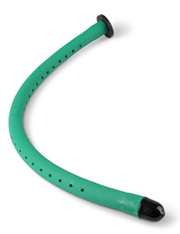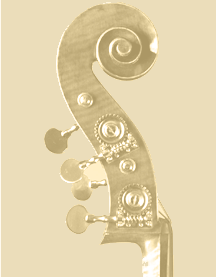Gewa Double Bass Humidifers
These are the new Gewa double bass humidifiers used to humidify
the interior body of a bass. In some super dry climates (like
where we are in the Phoenix area), we can and do use these all year
'round. Most though that live in more seasonal areas will only
have to worry about super dry times during the winter when the air
is cold and the home heater dries and heats the air inside.
While violins and cellos shrink and contract in similar ways and
percentage ratios, when a bass contracts, 2% can mean 1/4" or even
more. Adding humidity to the bass will help minimize the
change so that the bass will not crack! A 'weather crack'
(about 95% of bass cracks!) is caused when the natural moisture
content in the wood is lost during the dry months and then causes it
to contract and shink. The back, usually is the most
aggressive part of the bass in contraction (maple!) and will shink
more than the top. Again, if the seams to do not 'pop' open (between
ribs and back, or top) then the back pulls the ribs, which still
glued to the top, will then pull apart the softer spruce wood top.
So the pressure point or 'release' point...is your top! Also,
here is when flat back style basses can crack against the support
bracing in the bass.
How these work and how to use them. Both the
Dampit and Gewa style of humidifiers have been around for at least 4
decades! They are made from a latex rubber tube, with a super
absorbant sponge inside that acts as a 'wick" allowing the moisture
to evaporate into the (un-varnished) body interior, by simply
hanging inside from the f-holes. At the bottom 2 inches of the
tube, there are no holes. This is to keep excess water from
dripping into the bass and at the same time, feed that sponge wick
and evaporate into the bass. While basses have a nice
protective varnish on their exterior that has a protective seal,
inside the bass is bare wood and will absorb that moisture.
Buy your Bass Humidifers here:
When filling the Dampit with water, be sure not to over fill
them. Needless to say, we never want them to drip
inside the bass. The best way to use these is to simply hold them
under the faucet, then squeeze all the extra water out. If you
are not used to using them, try hanging them on a bathroom towell
rack and then come back in an hour or two to see if they are
dripping or not. You want to hear that "Squishy" sound at the
bottom of the tube, but not see dripping or water to come out of it
too easily when pinched. A little goes a long way, especially
if you use 4, which is the most effective way.
What works best. We have found that using
4 moderately moistened (safely) Gewa Humidifiers in your bass and storing it
with the cover on
and zipped
up, creates an optimal way for the bass to fully absolb the
much needed moisture. So, after a practice or playing session,
when you are finished with the bass for the day, hang the tubes in,
then put the cover on. This creates a safe, not overly wet
'bass humidor'. Without the cover, the nice humid air will
just evaporate out through the f-holes. The cover makes a
significant difference this way.
There are other ways to deal with humidity.
See our other dedicated humidity page where we explain some
other ways to help your bass along in the dry times of year.
|


